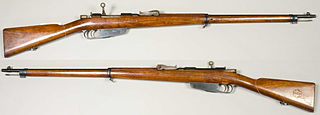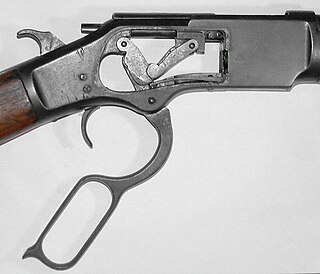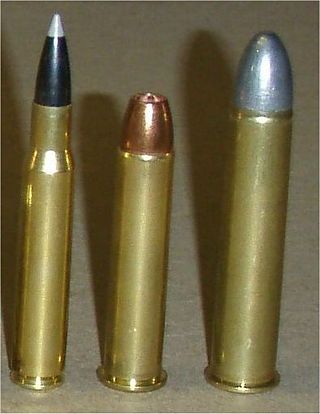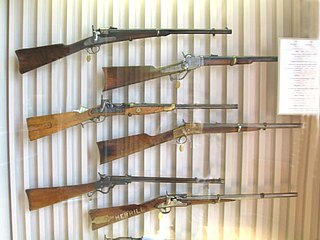
A rifle is a long-barreled firearm designed for accurate shooting and higher stopping power, with a barrel that has a helical pattern of grooves (rifling) cut into the bore wall. In keeping with their focus on accuracy, rifles are typically designed to be held with both hands and braced firmly against the shooter's shoulder via a buttstock for stability during shooting. Rifles are used extensively in warfare, law enforcement, hunting, shooting sports and crime.
Winchester rifle is a comprehensive term describing a series of lever action repeating rifles manufactured by the Winchester Repeating Arms Company. Developed from the 1860 Henry rifle, Winchester rifles were among the earliest repeaters. The Model 1873 was particularly successful, being marketed by the manufacturer as "The Gun That Won the West".

Carcano is the frequently used name for a series of Italian bolt-action, internal box magazine fed, repeating military rifles and carbines. Introduced in 1891, the rifle was chambered for the rimless 6.5×52mm Carcano round. It was developed by the chief technician Salvatore Carcano at the Turin Army Arsenal in 1890, and was originally called the Modello (model) 91 or simply M91. Successively replacing the previous Vetterli-Vitali rifles and carbines in 10.35×47mmR, it was produced from 1891 to 1945. The M91 was used in both rifle (fucile) and shorter-barreled carbine (moschetto) form by most Italian troops during World War I and by Italian and some German forces during World War II. The rifle was also used during the Winter War by Finland, and again by regular and irregular forces in Syria, Libya, Tunisia, and Algeria during various postwar conflicts in those countries.
A repeating rifle is a single-barreled rifle capable of repeated discharges between each ammunition reload. This is typically achieved by having multiple cartridges stored in a magazine and then fed individually into the chamber by a reciprocating bolt, via either a manual or automatic action mechanism, while the act of chambering the round typically also recocks the hammer/striker for the following shot. In common usage, the term "repeating rifle" most often refers specifically to manual repeating rifles, as opposed to self-loading rifles, which use the recoil, gas, or blowback of the previous shot to cycle the action and load the next round, even though all self-loading firearms are technically a subcategory of repeating firearms.

A lever action is a type of action for repeating firearms that uses a manually operated cocking handle located around the trigger guard area that pivots forward to move the bolt via internal linkages, which will feed and extract cartridges into and out of the chamber, and cock the firing pin mechanism. This contrasts to other type of repeating actions such as the bolt-action, pump-action, semi-automatic, fully automatic, and/or burst mode actions. A firearm using this operating mechanism is colloquially referred to as a levergun.
Pump action or slide action is a repeating firearm action that is operated manually by moving a sliding handguard on the gun's forestock. When shooting, the sliding forend is pulled rearward to eject any expended cartridge and typically to cock the hammer/striker, and then pushed forward to load (chamber) a new cartridge into the chamber. Most pump-action firearms use an integral tubular magazine, although some do use detachable box magazines. Pump-action firearms are typically associated with shotguns, although it has been used in rifles, grenade launchers, as well as other types of firearms.

The Remington M1867 was a rolling-block rifle, the first rifle using metallic cartridges to be adopted by the Norwegian and Swedish armies. Nominally it had a caliber of 4 decimal lines, but the actual caliber was 3.88 Norwegian decimal lines or 4.1 Swedish decimal lines (12.17 mm), and it fired a rimfire round with a 12.615 mm lead bullet. The 12.17 mm caliber was chosen because the Swedish army had approximately 30,000 new muzzle-loading M1860 and breech-loading M1864 rifles in 12.17 mm caliber in stock, rifles that were suitable for conversion to M1867 rolling-block rifles. With the exception of the first 10,000 rifles and 20,000 actions, which were made by Remington in the US, all Remington M1867 rifles and carbines were made under license in Norway and Sweden, by Kongsberg Vaapenfabrik in Norway, and by Husqvarna Vapenfabriks Aktiebolag and Carl Gustafs stads Gevärsfaktori in Sweden with the two Swedish manufacturers producing about 80% of the weapons.
The Spencer repeating rifles and carbines were 19th-century American lever-action firearms invented by Christopher Spencer. The Spencer was the world's first military metallic-cartridge repeating rifle, and over 200,000 examples were manufactured in the United States by the Spencer Repeating Rifle Co. and Burnside Rifle Co. between 1860 and 1869. The Spencer repeating rifle was adopted by the Union Army, especially by the cavalry, during the American Civil War but did not replace the standard issue muzzle-loading rifled muskets in use at the time. Among the early users was George Armstrong Custer. The Spencer carbine was a shorter and lighter version designed for the cavalry.
The Henry repeating rifle is a lever-action tubular magazine rifle famed both for its use at the Battle of the Little Bighorn and being the basis for the iconic Winchester rifle of the American Wild West.

The .45-70, also known as the .45-70 Government, .45-70 Springfield, and .45-21⁄10" Sharps, is a .45 caliber rifle cartridge originally holding 70 grains of black powder that was developed at the U.S. Army's Springfield Armory for use in the Springfield Model 1873. It was a replacement for the stop-gap .50-70 Government cartridge, which had been adopted in 1866, one year after the end of the American Civil War, and is known by collectors as the "Trapdoor Springfield".

The M1819 Hall rifle was a single-shot breech-loading rifle designed by John Hancock Hall, patented on May 21, 1811, and adopted by the U.S. Army in 1819. It was preceded by the Harpers Ferry M1803. It used a pivoting chamber breech design and was made with either flintlock or percussion cap ignition systems. The years of production were from the 1820s to the 1840s at the Harpers Ferry Arsenal. This was the first breech-loading rifle to be adopted in large numbers by any nation's army, but not the first breech-loading military rifle – the Ferguson rifle was used briefly by the British Army in the American Revolutionary War. The Hall rifle remained overshadowed by common muskets and muzzleloading rifles which were still prevalent until the Civil War. The early flintlocks were mostly converted to percussion ignition.
The British .577 Snider–Enfield was a breech-loading rifle. The American inventor, Jacob Snider created this firearm action, and the Snider–Enfield was one of the most widely used of the Snider varieties. The British Army adopted it in 1866 as a conversion system for its ubiquitous Pattern 1853 Enfield muzzle-loading rifles, and used it until 1874 when the Martini–Henry rifle began to supersede it. The British Indian Army used the Snider–Enfield until the end of the nineteenth century.

The origins of the modern British military rifle are within its predecessor the Brown Bess musket. While a musket was largely inaccurate over 100 yards (91 m), due to a lack of rifling and a generous tolerance to allow for muzzle-loading, it was cheap to produce and could be loaded quickly. The use in volley or in mass firing by troops meant that rate of fire took precedence over accuracy.

The Remington Model 14 was a pump-action repeating rifle designed for the Remington Arms company by John Pedersen. It is part of a series of rifles that include the Remington Model 14-1/2 and the Remington Model 141.
The Marlin Model 336 is a lever-action rifle and carbine made by Marlin Firearms. Since its introduction in 1948, it has been offered in a number of different calibers and barrel lengths, but is commonly chambered in .30-30 Winchester or .35 Remington, using a 20- or 24-inch barrel. Currently, the model with a 24-inch barrel is only available in .30-30 Winchester. The Model 336 is now back in production as of March 27, 2023.
The Winchester Model 1894 rifle is a lever-action repeating rifle that became one of the most famous and popular hunting rifles of all time. It was designed by John Browning in 1894 and originally chambered to fire two metallic black powder cartridges, the .32-40 Winchester and .38-55 Winchester. It was the first rifle to chamber the smokeless powder round, the .30 WCF in 1895. In 1901, Winchester created the new .32 Winchester Special caliber with production of rifles starting in 1902.
During the American Civil War, an assortment of small arms found their way onto the battlefield. Though the muzzleloader percussion cap rifled musket was the most numerous weapon, being standard issue for the Union and Confederate armies, many other firearms, ranging from the single-shot breech-loading Sharps and Burnside rifles to the Spencer and the Henry rifles - two of the world's first repeating rifles - were issued by the hundreds of thousands, mostly by the Union. The Civil War brought many advances in firearms technology, most notably the widespread use of rifled barrels.

The Merrill carbine was a breechloader firearm designed by Baltimore, Maryland gunsmith and inventor James H. Merrill. It was one of several firearms either manufactured or altered by Merrill in fulfillment of contracts with the Union government during the U.S. Civil War.
The Winchester Hotchkiss was a bolt-action repeating rifle patented by Benjamin B. Hotchkiss in 1876 and produced by the Winchester Repeating Arms Company and Springfield Armory from 1878. The Hotchkiss, like most early bolt-actions, had a single rear locking lug integral with the bolt handle, but was unique in feeding multiple rounds from a tubular buttstock magazine similar to the Spencer rifle. The .45-70 Hotchkiss was acquired in limited numbers by the US Navy as the M1879, and by the US Army and several state militias as the M1883, making it the first center-fire bolt-action repeater to be adopted by any major military.
The Winchester Model 1903 was the first commercially available semi-automatic firearm made by the Winchester Repeating Arms Company.













